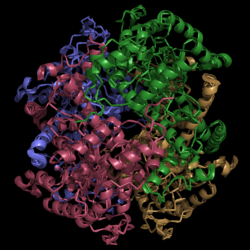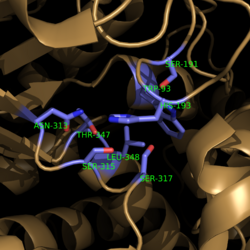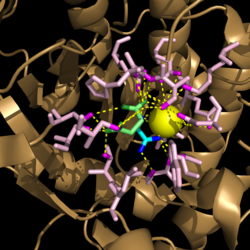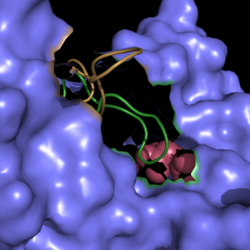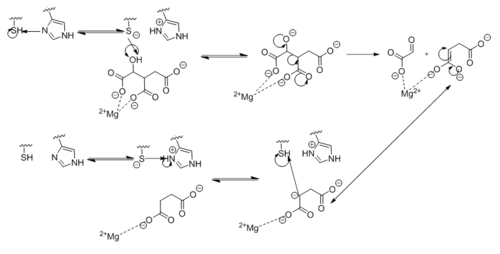Sandbox Reserved 1058
From Proteopedia
(Difference between revisions)
| Line 4: | Line 4: | ||
Isocitrate lyase is a [[lyase]] found in the proteome of multiple bacteria that oxidizes the hydroxl group of [https://en.wikipedia.org/wiki/Isocitric_acid isocitrate] and cleaves the substrate in two forming [https://en.wikipedia.org/wiki/Glyoxylic_acid glyoxylate] and [https://en.wikipedia.org/wiki/Succinic_acid succinate]. Isocitrate lyase is a tetramer that is composed primarily of alpha helices and beta sheets with a unique structural phenomenon called "<scene name='69/694225/Helix_swapping/1'>helix swapping</scene>". This enzyme can be found within the cytosol of bacteria and is used in a variation of the citric acid cycle to help conserve energy by not using [http://en.wikipedia.org/wiki/Nicotinamide_adenine_dinucleotide_phosphate NADPH] as an electron carrier and by reforming [http://en.wikipedia.org/wiki/Coenzyme_A coenzyme-A] earlier than in the normal citric acid cycle. | Isocitrate lyase is a [[lyase]] found in the proteome of multiple bacteria that oxidizes the hydroxl group of [https://en.wikipedia.org/wiki/Isocitric_acid isocitrate] and cleaves the substrate in two forming [https://en.wikipedia.org/wiki/Glyoxylic_acid glyoxylate] and [https://en.wikipedia.org/wiki/Succinic_acid succinate]. Isocitrate lyase is a tetramer that is composed primarily of alpha helices and beta sheets with a unique structural phenomenon called "<scene name='69/694225/Helix_swapping/1'>helix swapping</scene>". This enzyme can be found within the cytosol of bacteria and is used in a variation of the citric acid cycle to help conserve energy by not using [http://en.wikipedia.org/wiki/Nicotinamide_adenine_dinucleotide_phosphate NADPH] as an electron carrier and by reforming [http://en.wikipedia.org/wiki/Coenzyme_A coenzyme-A] earlier than in the normal citric acid cycle. | ||
==Isocitrate Lyase== | ==Isocitrate Lyase== | ||
| - | ===Structure=== | + | === Structure=== |
[[Image:Normal_Crystal_Structure.png|250 px|left|thumb|'''Figure 1. Crystal Structure of Isocitrate Lyase.''' Quaternary structure is comprised of four subunits forming an alpha/beta barrel.]] | [[Image:Normal_Crystal_Structure.png|250 px|left|thumb|'''Figure 1. Crystal Structure of Isocitrate Lyase.''' Quaternary structure is comprised of four subunits forming an alpha/beta barrel.]] | ||
[http://www.rcsb.org/pdb/explore/explore.do?structureId=1f8i Isocitrate lyase] is a tetramer with 222 symmetry. Each subunit is composed of 14 alpha helices and 14 beta sheets which includes a total of 426 residues. These α helices and β sheets form an unusual α/β barrel seen in Figure 1. The α/β barrel contains a topology of (βα)<sub>2</sub>α(βα)<sub>5</sub>β, differing from the canonical (βα)<sub>8</sub> pattern. Residues 184-200 and 235-254 connects the third and forth β-strands to their consecutive helices and form a <scene name='69/694225/Small_beta_domain/1'>small β-domain</scene> that consists of a short five-stranded βsheet (β6,β7,β9,β10,β11) that lies on top of the α/β barrel. <ref name="sharma"> Sharma, V.; Sharma, S.; Hoener zu Bentrup, K.; McKinney, J.; Russell, D.; ''et. al''; Structure of isocitrate lyase, a persistence factor of ''Mycobacterium tuberculosis''. ''Nat. Struct. Biol.''. '''2000'''. ''7(8)'':663-668. </ref> A study of the equilibria between the four subunits shows that each isocitrate lyase monomer has a dynamic comformational change of the active site loop. At any given time, only two of the subunits are in the open conformation. <ref name="gould"> Gould, T.; van de Langemheen, H.; Muñoz-Elías, E.; McKinney, D.; Sacchettini, J.; Dual role of isocitrate lyase 1 in the glyoxylate and methylcitrate cycles in ''Mycobacterium tuberculosis''. ''Molecular Microbiology''. '''2006'''. ''61(4)'':940-947. doi:10.1111/j.1365-2958.2006.05297.x. </ref> Isocitrate Lyase shows a resemblance to [http://www.rcsb.org/pdb/explore/explore.do?structureId=1S2V phosphoenolpyrvate mutase]. <ref name="sharma"> Sharma, V.; Sharma, S.; Hoener zu Bentrup, K.; McKinney, J.; Russell, D.; ''et. al''; Structure of isocitrate lyase, a persistence factor of ''Mycobacterium tuberculosis''. ''Nat. Struct. Biol.''. '''2000'''. ''7(8)'':663-668. </ref> | [http://www.rcsb.org/pdb/explore/explore.do?structureId=1f8i Isocitrate lyase] is a tetramer with 222 symmetry. Each subunit is composed of 14 alpha helices and 14 beta sheets which includes a total of 426 residues. These α helices and β sheets form an unusual α/β barrel seen in Figure 1. The α/β barrel contains a topology of (βα)<sub>2</sub>α(βα)<sub>5</sub>β, differing from the canonical (βα)<sub>8</sub> pattern. Residues 184-200 and 235-254 connects the third and forth β-strands to their consecutive helices and form a <scene name='69/694225/Small_beta_domain/1'>small β-domain</scene> that consists of a short five-stranded βsheet (β6,β7,β9,β10,β11) that lies on top of the α/β barrel. <ref name="sharma"> Sharma, V.; Sharma, S.; Hoener zu Bentrup, K.; McKinney, J.; Russell, D.; ''et. al''; Structure of isocitrate lyase, a persistence factor of ''Mycobacterium tuberculosis''. ''Nat. Struct. Biol.''. '''2000'''. ''7(8)'':663-668. </ref> A study of the equilibria between the four subunits shows that each isocitrate lyase monomer has a dynamic comformational change of the active site loop. At any given time, only two of the subunits are in the open conformation. <ref name="gould"> Gould, T.; van de Langemheen, H.; Muñoz-Elías, E.; McKinney, D.; Sacchettini, J.; Dual role of isocitrate lyase 1 in the glyoxylate and methylcitrate cycles in ''Mycobacterium tuberculosis''. ''Molecular Microbiology''. '''2006'''. ''61(4)'':940-947. doi:10.1111/j.1365-2958.2006.05297.x. </ref> Isocitrate Lyase shows a resemblance to [http://www.rcsb.org/pdb/explore/explore.do?structureId=1S2V phosphoenolpyrvate mutase]. <ref name="sharma"> Sharma, V.; Sharma, S.; Hoener zu Bentrup, K.; McKinney, J.; Russell, D.; ''et. al''; Structure of isocitrate lyase, a persistence factor of ''Mycobacterium tuberculosis''. ''Nat. Struct. Biol.''. '''2000'''. ''7(8)'':663-668. </ref> | ||
| Line 18: | Line 18: | ||
| - | ===Active Site=== | + | === Active Site=== |
[[Image:Active Site Residues.png|250 px|left|thumb|'''Figure 3. Active Site Residues.''' All eight active site residues necessary for catalysis of isocitrate are shown in slate. However, the protein shown is a C191S mutant of isocitrate lyase.]] [[Image:Active_Site_Hydrogen_Bonding.png|250 px|right|thumb|'''Figure 4. Active site residues hydrogen bound to a cofactor and the products of the catalyzed isocitrate reaction.''' Glyoxylate is shown in blue, succinate is shown in green, and the Mg<sup>2+</sup> cofactor is shown in yellow.]] The active site of isocitrate lyase consists of eight residues: Trp93, Cys191, His193, Ser315, Ser317, Asn313, Thr347, Leu348 (Figure 3). Additionally, there are several other amino acid side chains present that form hydrogen bonding opportunities with isocitrate to catalyze the breakdown reaction to glyoxylate and succinate. Ser91, Gly92, Trp93, and Arg228 form hydrogen bonds with glyoxylate while Asn313, Glu295, Arg228, and Gly192 and Trp93, Thr347, Ser315, Ser317, and His193 form hydrogen bonding opportunities with the two carboxylates within succinate. <ref name="sharma"> Sharma, V.; Sharma, S.; Hoener zu Bentrup, K.; McKinney, J.; Russell, D.; ''et. al''; Structure of isocitrate lyase, a persistence factor of ''Mycobacterium tuberculosis''. ''Nat. Struct. Biol.''. '''2000'''. ''7(8)'':663-668. </ref> Additionally, a Mg<sup>2+</sup> ion is needed for further electrostatic stabilization of the extreme negative charge on isocitrate. This Mg<sup>2+</sup> hydrogen bonds to the carboxylate in glyoxylate and one of the carboxylates in succinate. | [[Image:Active Site Residues.png|250 px|left|thumb|'''Figure 3. Active Site Residues.''' All eight active site residues necessary for catalysis of isocitrate are shown in slate. However, the protein shown is a C191S mutant of isocitrate lyase.]] [[Image:Active_Site_Hydrogen_Bonding.png|250 px|right|thumb|'''Figure 4. Active site residues hydrogen bound to a cofactor and the products of the catalyzed isocitrate reaction.''' Glyoxylate is shown in blue, succinate is shown in green, and the Mg<sup>2+</sup> cofactor is shown in yellow.]] The active site of isocitrate lyase consists of eight residues: Trp93, Cys191, His193, Ser315, Ser317, Asn313, Thr347, Leu348 (Figure 3). Additionally, there are several other amino acid side chains present that form hydrogen bonding opportunities with isocitrate to catalyze the breakdown reaction to glyoxylate and succinate. Ser91, Gly92, Trp93, and Arg228 form hydrogen bonds with glyoxylate while Asn313, Glu295, Arg228, and Gly192 and Trp93, Thr347, Ser315, Ser317, and His193 form hydrogen bonding opportunities with the two carboxylates within succinate. <ref name="sharma"> Sharma, V.; Sharma, S.; Hoener zu Bentrup, K.; McKinney, J.; Russell, D.; ''et. al''; Structure of isocitrate lyase, a persistence factor of ''Mycobacterium tuberculosis''. ''Nat. Struct. Biol.''. '''2000'''. ''7(8)'':663-668. </ref> Additionally, a Mg<sup>2+</sup> ion is needed for further electrostatic stabilization of the extreme negative charge on isocitrate. This Mg<sup>2+</sup> hydrogen bonds to the carboxylate in glyoxylate and one of the carboxylates in succinate. | ||
Revision as of 04:39, 10 April 2015
Isocitrate Lyase from Mycobacterium tuberculosis
| |||||||||||
References
- ↑ 1.0 1.1 1.2 1.3 1.4 1.5 Sharma, V.; Sharma, S.; Hoener zu Bentrup, K.; McKinney, J.; Russell, D.; et. al; Structure of isocitrate lyase, a persistence factor of Mycobacterium tuberculosis. Nat. Struct. Biol.. 2000. 7(8):663-668.
- ↑ Gould, T.; van de Langemheen, H.; Muñoz-Elías, E.; McKinney, D.; Sacchettini, J.; Dual role of isocitrate lyase 1 in the glyoxylate and methylcitrate cycles in Mycobacterium tuberculosis. Molecular Microbiology. 2006. 61(4):940-947. doi:10.1111/j.1365-2958.2006.05297.x.
- ↑ Cozzone, A.; Regulation of acetate metabolism by protein phosphorylation in enteric bacteria. Annual Review of Microbiology. 1998, 52:127-164. doi: 10.1146/annurev.micro.52.1.127.
- ↑ Srivastava, V.; Janin, A.; Srivastava, B.; Srivastava, R.; Selection of genes of Mycobacterium tuberculosis upregulated during residence in lungs of infected mice. ScienceDirect. 2007. doi:10.1016/j.tube.2007.10.002.
- ↑ Muñoz-Elías, E.; McKinney, J.; M. tuberculosis isocitrate lyases 1 and 2 are jointly required for in vivo growth and virulence. Nat. Med. 2005. 11(6):638-644. doi:10.1038/nm1252.
- ↑ Dunn, M.; Ramírez-Trujillo, J.; Hernández-Lucas, I.; Major roles of isocitrate lyase and malate synthase in bacterial and fungal pathogenesis. Microbiology. 2009. 155:3166-3175. doi:10.1099/mic.0.030858-0.
